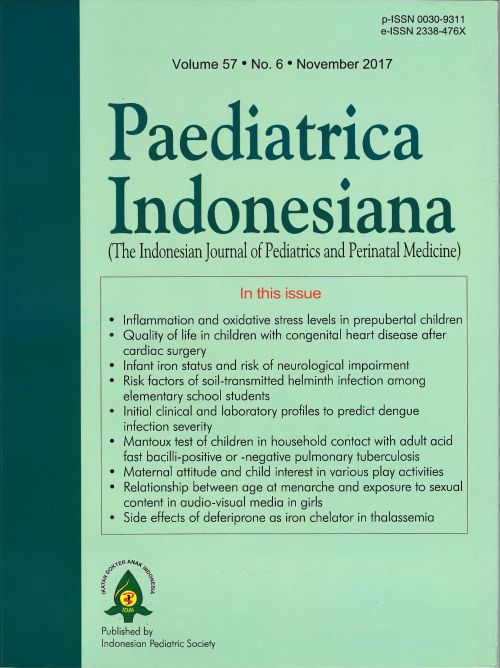Initial clinical and laboratory profiles to predict pediatric dengue infection severity
Abstract
Background. In dengue infection, it is difficult to differentiate mild and severe dengue prior to its critical phase. Ability to identify risk factors for severe dengue form patients' initial presentation would help decrease the need of hospitalization, increase physicians' awareness, and improve outcome.
Objective. To predict pediatric dengue infection severity based on initial patient characteristics, routine clinical and laboratory profiles.
Methods. This was a cross-sectional study based on medical records of children with dengue infection in Atma Jaya Hospital, Jakarta. Inclusion criteria were children aged 1 - 18 years old with proven dengue infection, hospitalized in Atma Jaya Hospital during January - December 2016. Clinical profiles and laboratory parameters at the time of patient presentation were extracted and analyzed in relationship with dengue severity.
Result. Data collected was 110 patients with mean age 9.5 years old. Initial clinical profiles that significantly related to severe dengue were: age <=5 years old (OR = 0.113, p = 0.001), hepatomegaly (OR = 2.643, p = 0.035), pleural effusion (OR = 9.545, p = 0.000), platelet <=125,000/uL (OR = 0.201, p = 0.025), hyponatremia (OR = 10.139, p = 0.000) and AST >135 u/L (OR = 5.112, p = 0.014). Gender, duration of fever, additional symptoms, spontaneous bleeding, blood pressure, pulse pressure, hematocrit, leucocyte, random blood glucose, calcium, and ALT were not related significantly to dengue severity.
Conclusion. Physician should be cautious in pediatric dengue patients presented in age younger than 5 years old, with hepatomegaly and/or pleural effusion, platelet below 125,000/uL, hyponatremia, and AST more than three times upper normal limit. These patients have higher risk of severe dengue than patients without those findings.
References
Pawitan JA. Dengue virus infection: predictors for severe dengue. Acta Med Indones. 2011;43:129-34.
Potts JA, Gibbons RV, Rothman AL, Srikiatkachorn A, et al. Prediction of dengue disease severity among pediatric Thai patients using early clinical laboratory indicators. PloS Negl Trop Dis. 2010;4:e769. doi: 10.1371/journal.pntd.0000769.
Pongpan S, Wisitwong A, Tawichasri C, Patumanond J, Namwongprom S. Development of dengue infection severity score. ISRN Pediatrics. 2013;ID 845876.
World Health Organization. Dengue hem¬orrhagic fever: diagnosis, treatment, prevention and control. Geneva: World Health Organization; 1997. Available from: http://www.who.int/csr/resources/publications/dengue/Denguepublication/en.
Lai WP, Chien TW, Lin HJ, Su SB, Chang CH. A screening tool for dengue fever in children. Pediatr Infect Dis J. 2013;32:320–4.
Dewi LP, Nurfitri E. Pediatric logistic organ dysfunction score as a predictive tool of dengue shock syndrome outcomes. Paediatr Indones. 2012;52:72–7.
Carlos CC, Oishi K, Cinco MTDD, et al. Comparison of clinical fea¬tures and hematologic abnormalities between dengue fever and dengue hemorrhagic fever among children in the Philippines. Am J Trop Med Hyg. 2005;73:435–40.
Pongpan S, Wisitwong A, Tawichasri C, Patumanond J, Namwongprom S. Validation of dengue infection severity score. Risk Manag Healthc Policy. 2014;7;45-9.
Yacoub S, Wils B. Predicting outcome for dengue. BMC Medicine. 2014;12:147.
Deen J, Lum L, Martinez E, Tan LH. Clinical management and delivery of clinical services. WHO. Dengue guidelines for diagnosis, treatment, prevention and control. New edition. Geneva: WHO;2009. p. 23-55.
Lovera D, Cuellar CM, Araya S, Amarilla S, et al. Clinical characteristics and risk factors of dengue shock syndrome in children. Pediatr Infect Dis J. 2016;35:1294–9.
Martina BEE, Koraka P, Osterhaus ADME. Dengue virus pathogenesis: an integrated view. Clin Microbiol Rev. 2009;22:564-81. doi: 10.1128/CMR.00035-09.
Pongpan S, Wisitwong A, Tawichasri C, Patumanond J. Prognostic indicators for dengue infection severity. Int J Clin Pediatr. 2013;2:12-18.
Zhang H, Zhou YP, Peng HJ, Zhou FY, et al. Predictive symptoms and signs of severe dengue disease for patients with dengue fever: a meta-analysis. BioMed Res Int. 2014: ID 359308. http://dx.doi.org/10.1155/2014/359308.
Reddy AA, Reddy TP, Pranam GM, Pranam U, Manjunath GA. Serum sodium as prognostic marker in dengue fever cases admitted to PICU in Navdaya hospital, Raichur, India. Int J Contemp Pediatr. 2017;4:222-5.
Lumpaopong A, Kaewplang P, Watanaveeradej V, Thirakhupt P, et al. Southeast Asian J Trop Med Public Health. 2010;41:72-6.
Leel LK, Gan VC, Leel V, Tan AS, et al. Clinical relevance and discriminatory value of elevated liver aminotransferase levels for dengue severity. PLoS Negl Trop Dis. 6: e1676. https://doi.org/10.1371/journal.pntd.0001676.
Mishra S, Ramanathan R, Agarwalla SK. Clinical profile of dengue fever in children: a study from Southern Odisha, India. Scientifica. 2016; ID 6391594. http://dx.doi.org/10.1155/2016/6391594.
Authors who publish with this journal agree to the following terms:
Authors retain copyright and grant the journal right of first publication with the work simultaneously licensed under a Creative Commons Attribution License that allows others to share the work with an acknowledgement of the work's authorship and initial publication in this journal.
Authors are able to enter into separate, additional contractual arrangements for the non-exclusive distribution of the journal's published version of the work (e.g., post it to an institutional repository or publish it in a book), with an acknowledgement of its initial publication in this journal.
Accepted 2017-12-15
Published 2018-01-05













